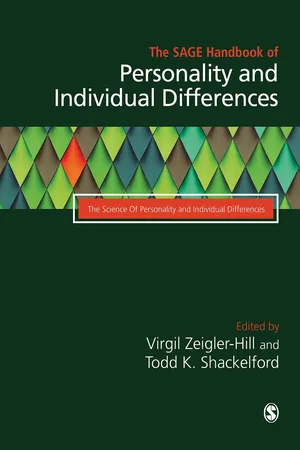
The SAGE Handbook of Personality and Individual Differences
Volume I: The Science of Personality and Individual Differences
- 672 pages
- English
- ePUB (mobile friendly)
- Available on iOS & Android
The SAGE Handbook of Personality and Individual Differences
Volume I: The Science of Personality and Individual Differences
About This Book
The examination of personality and individual differences is a major field of research in the modern discipline of psychology. Concerned with the ways humans develop an organised set of characteristics to shape themselves and the world around them, it is a study of how people come to be 'different? and 'similar? to others, on both an individual and a cultural level. This volume explores the scientific foundations of personality and individual differences, in chapters arranged across three thematic sections: Part 1: Theoretical Perspectives on Personality and Individual DifferencesPart 2: Research Strategies for Studying Personality and Individual DifferencesPart 3: The Measurement of Personality and Individual DifferencesWith outstanding contributions from leading scholars across the world, this is an invaluable resource for researchers and graduate students.
Frequently asked questions
Information
Part I Theoretical Perspectives on Personality and Individual Differences
1 Defining Traits

Source: McCrae (2013). From ‘Exploring trait assessment of samples, persons, and cultures,’ by R. R. McCrae, 2013, Journal of Personality Assessment, 95, p. 557. Copyright 2013 by Taylor and Francis.
The Nature of Traits
An Evolving Definition
A Trait by Any Other Name …
Table of contents
- Cover
- Half Title
- Editorial Board
- Title Page
- Copyright Page
- Contents
- List of Figures
- List of Tables
- Notes on the Editor and Contributors
- Part I Theoretical Perspectives on Personality and Individual Differences
- 1 Defining Traits
- 2 Personality in Nonhuman Animals: Comparative Perspectives and Applications
- 3 The Psychodynamic Perspective
- 4 The Transdisciplinary Philosophy-of-Science Paradigm for Research on Individuals: Foundations for the Science of Personality and Individual Differences
- 5 Socioanalytic Theory: Basic Concepts, Supporting Evidence and Practical Implications
- 6 Why Do Traits Come Together? The Underlying Trait and Network Approaches
- 7 Implicit Theories of Personality Across Development: Impacts on Coping, Resilience and Mental Health
- 8 Contemporary Integrative Interpersonal Theory of Personality
- 9 Evolutionary Perspectives on Personality and Individual Differences
- Part II Research Strategies for Studying Personality and Individual Differences
- 10 Measuring Personality Processes in the Lab and the Field
- 11 Movement Pattern Analysis (MPA): Decoding Individual Differences in Embodied Decision Making
- 12 The Various Roles of Replication in Scientific Research
- 13 Implicit Measures
- 14 Ambulatory Monitoring and Ambulatory Assessment in Personality Research
- 15 Behavioral Observation in the Study of Personality and Individual Differences
- 16 What Do We Know When We LIWC a Person? Text Analysis as an Assessment Tool for Traits, Personal Concerns and Life Stories
- 17 Longitudinal Data Analysis for Personality Psychologists
- 18 The Network Structure of Personality Psychology: What The SAGE Handbook of Personality and Individual Differences1 Tells Us about the Nature of the Field
- Part III The Measurement of Personality and Individual Differences
- 19 Pathological Personality Traits: The Movement toward Dimensional Approaches to Psychopathology
- 20 Conceptualizing and Measuring Intelligence
- 21 Measurement of Situational Influences
- 22 Taxometric Analysis
- 23 Within-person Variability in Narcissism
- 24 Interpersonal Perception Models
- 25 Accounting for Socially Desirable Responding in Personality Assessment
- 26 Personality Assessment in Forensic Psychology
- 27 Measuring the Dark Side of Personality
- 28 Putting Time in a Wider Perspective: The Past, the Present and the Future of Time Perspective Theory
- Index